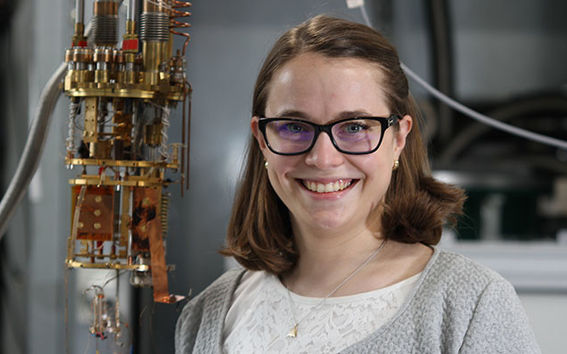Finding the unknown, D.Sc. Natalie Segercrantz

’No-one has done this before. I am the first to see what happens. The opportunity to discover new things is what draws me to physics and laboratory work’, says Natalie Segercrantz, 30. She completed her doctorate in the field of engineering physics at Aalto University last spring.
Segercrantz’s dissertation was basic research, laboratory work on the cusp of something new. She studied the changes caused by lattice defects to the properties of the semiconductor gallium antimonide and two of its alloys.
Lattice defects are the results of individual atoms being removed from a material. They can occur when matter is heated, for example.
Due to its optical and electrical properties, gallium antimonide is used in a number of applications, from solar cells to LED lights.
’Inventing new applications for gallium antimonide was not the aim of my doctoral research, but now that a clearer picture of its behaviour has been established, further studies may result in new use cases for the compound’, Segercrantz notes.
For girls and for boys
Segercrantz’s path to a career in physics did not follow a straight line. Even in secondary school she still found physics dreadfully dull, but in upper secondary school her interest in the field was sparked by an inspiring teacher.
’Physics became like reading a detective story, only the perpetrator was rarely revealed due to the number of factors that had not been studied yet. I walked out of class with a thirst for knowledge. I wanted to go to Otaniemi to study and find the answers myself.’
Being a girl who liked physics occasionally raised eyebrows among Segercrantz’s friends in upper secondary school.
’I am lucky to have had such supportive parents. Both of them are engineers. I truly wish girls interested in physics would dare follow their dreams without caring about the thoughts of others. Physics suits girls and boys just as well’, Segercrantz says.
International contacts
The dissertation took Segercrantz three and a half years, split between two countries and two research laboratories. In addition to the Otaniemi campus, she worked at the Lawrence Berkeley National Laboratory.
’Working with two different research groups was a great experience. I saw that even if the contrast between cultures can be stark, the world of science is the same wherever you go. Having two supervisors during my dissertation work was also an advantage. The best way to learn is to work with someone who is more skilled than yourself.’
Segercrantz is also happy for the colleagues she met during her work abroad. In the world of science, connections are essential.
Today, she is a postgraduate researcher at the Walther Meissner Institute for Low Temperature Physics in Munich. The study of gallium antimonide has given way for low-temperature physics.
’I don’t yet know what the future holds. Will I stay abroad or return to Finland? I would like to keep working with science. The further one goes in the world of science, the tougher the competition is for open positions. I wonder if I could come up with the essential questions to find answers for.’
Read more news

Get to know us: Associate Professor Maria Sammalkorpi
Sammalkorpi received her doctorate from Helsinki University of Technology 2004. After her defence, she has worked as a researcher at the Universities of Princeton, Yale and Aalto.
Aalto computer scientists in ICML 2024
Computer scientists in ICML 2024
Getting bacteria into line
Physicists use magnetic fields to manipulate bacterial behaviour